

You’re going to cover hundreds of kilometres on foot during your round-the-world (RTW) trip. Therefore, don’t overlook your shoe choice. In this article, we’ll explain the criteria to take into account so that you know how many pairs, what type of shoes to take and how to choose the right ones for you. To help you make sense of it all, we’ve carefully compared the models most frequently used by RTW travellers.
We carried out a large survey between 12th and 16th July 2017, amongst 606 RTW travellers, in which we asked them how many shoes they’d taken, as well as what types, brands and models they’d chosen. Learn more about our methodology
Most RTW travellers set off with two or three pairs.
Women:
Men:
The more shoes you pack, the heavier your backpack will be.
The number and type of shoes you choose to take will depend on several factors:
These boots are most commonly used by hikers. They wrap around the ankle and therefore help maintain stability. They’re pretty waterproof, have good shock absorption and protect your ankles from sharp objects like rocks and thorns.
However, they have several drawbacks: they’re quite heavy, not that breathable and take a long time to dry. Given that the shocks are barely absorbed by the calves, they can then affect the knees. What’s more, in the long run, as the ankle is constantly supported, the ligaments end up losing their natural flexion, which increases the risk of injury.
This type of shoe is therefore more suitable for occasional hikes than for long trips.
Main brands: Quechua, Merrell, The North Face, Columbia…
Our opinion: We don’t recommend this type of shoe for going on a RTW trip, unless your ankles aren’t trained (muscular) and you plan on doing really technical treks.
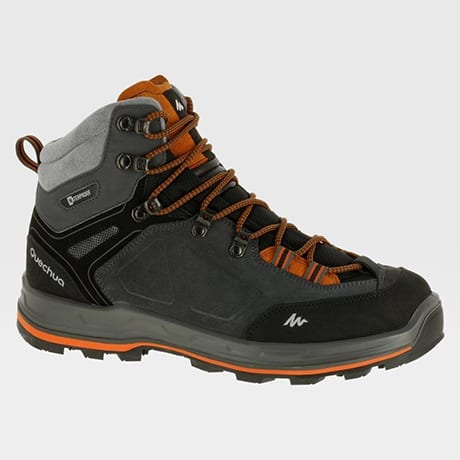

The Quechua Trek 100
If you intend on doing lots of treks during your RTW trip, you can opt for low-cut hiking boots that are lightweight, comfortable and usually quite affordable. They’ll be suitable enough for long hikes on rough or slippery terrain and can also most definitely be used in the city, although they’re a little heavy.
Main brands: Quechua, Merrell, The North Face, Columbia…
Our opinion: Choose this type of shoe for a long trip if you seriously plan on doing technical treks and you don’t mind the look of them.


The Merrell Moab Ventilator
Originally, this type of shoe was made for long runs in the mountains. They’re halfway between low-cut hiking boots and running shoes.
They’re lighter and therefore easier to carry when you’re walking around in flip-flops. Their style, similar to trainers, is more versatile in the city. Finally, they offer sufficient grip and cushioning on long hikes.
Main brands: Salomon, Quechua, Adidas, Asics…
Our opinion: This is the most suitable type of shoe for a RTW trip if you intend on trekking.
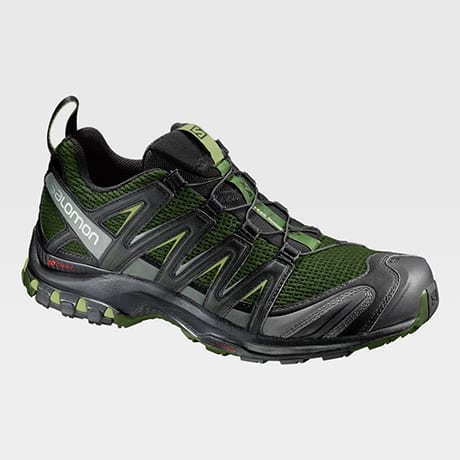

The Salomon XA Pro 3D
These are “classic” running trainers. They’re usually really light and comfortable. However, they may not withstand intensive use during a RTW trip. What’s more, they offer neither sufficient grip nor stiffness on long mountain hikes.
Main brands: Nike, Adidas, Kalenji, Asics…
Our opinion: We don’t recommend this type of shoe for going on a RTW trip.


The Nike Tanjun
Some travellers prefer having basic city trainers when they’re abroad. They have the advantage of being really versatile, of avoiding an overly touristy look and of being a little more stylish for going out at night.
You can bring a light pair of trainers in addition to your walking boots or trail shoes. You can also use them as your main pair of shoes if you’re not too bothered about trekking.
Main brands: Adidas, Converse, New Balance…
Our opinion: This type of shoe can be taken along as an extra pair, for city stays and nights out. So, go for the lightest model possible. If you don’t really like the style of walking boots or trail shoes, city trainers can also serve as your main pair of shoes, so go for a pretty sturdy model.
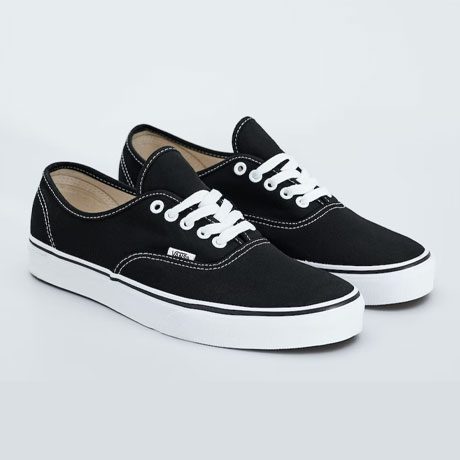

The Vans Authentic canvas trainer
Sandals are particularly suited to very hot and humid weather conditions, such as monsoons. You’ll have wet feet. But, given the heat that prevails in the tropics, they’ll dry very quickly as soon as the rain stops.
Some hiking sandals models, with straps that hold your foot in place nicely and notched soles, are ideal for walking on slightly uneven and rocky ground, or in the city. If you don’t mind walking in mud and getting wet feet, and you’re comfortable with the style, they might be a good option for you.
Undoubtedly for a question of aesthetics, more women than men (50% to 18%) opt for sandals. They mostly go for light sandals that can be used as everyday shoes.
Main brands: Merrell, Keen, Birkenstock…
Our opinion: This type of shoe is a good option if you want to take a third pair.
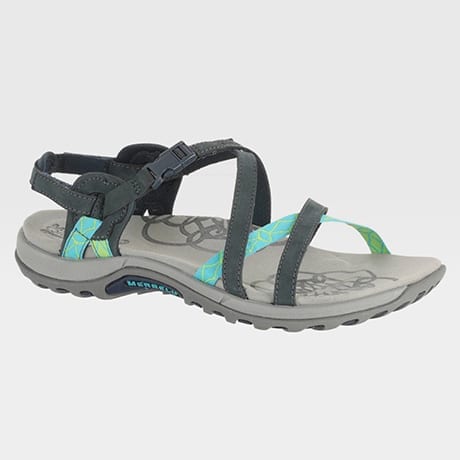

The Merrell Jacardia
Being lightweight and compact, it’s really nice to wear flip-flops in hot weather either in the city or at the beach. They’re also very handy for communal or unhygienic showers. You’ll easily find them in the countries you visit. However, don’t hesitate over investing in a decent brand, as the sole of low-end flip-flops packs very quickly and the straps break easily. Sylvain had to buy 5 pairs of flip-flops during our RTW trip.
Main brands: Havaianas, Tribord, Roxy…
Our opinion: Flip-flops are essential! It’s probably the pair of shoes you’ll use the most during your trip.
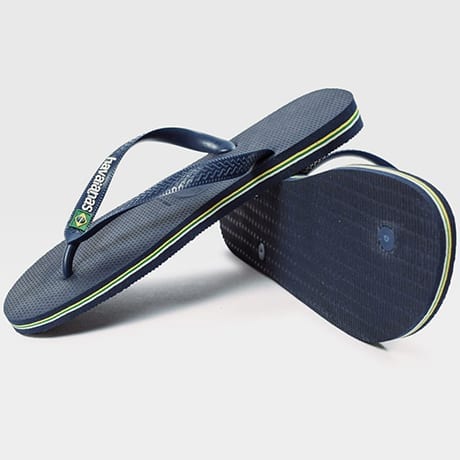

The popular Havaianas
Women:
Men:
Flip-flops are widely approved by RTW travellers. They’re used as everyday “shoes” in hot countries. They’re almost always used in combination with walking boots / trail shoes. Travellers who choose to take a third pair of shoes (mostly women), opt for city trainers or sandals.
Women:
Men:
You’ve probably noticed that at AwayForLong, we recommend travelling light. Therefore, we advise you to limit yourself to two pairs of shoes (three tops). In our opinion, the best combo is:
On the face of it, if you go with children, you shouldn’t do hikes that are too difficult during your trip. So, we advise you to take them a pair of trainers with good grip, as well as a pair of sandals.
In this section, we’ll go through all the selection criteria to take into account when choosing your trail shoes or hiking boots.
When trying on a pair of shoes, make sure your toes don’t touch the end of the shoe. This’ll prevent blisters and black toenails. Keep about a centimetre between the toes and the end of the shoe. Therefore, your trail shoes or hiking boots will usually be one size up from your city shoes.
It’s important to take your stride into account when choosing your shoes.
To find out your stride type, you can look at the wear of the soles of your old sports shoes. However, it’s even better to have your stride analysed by an expert from a specialist store, a podiatrist or a physiotherapist.
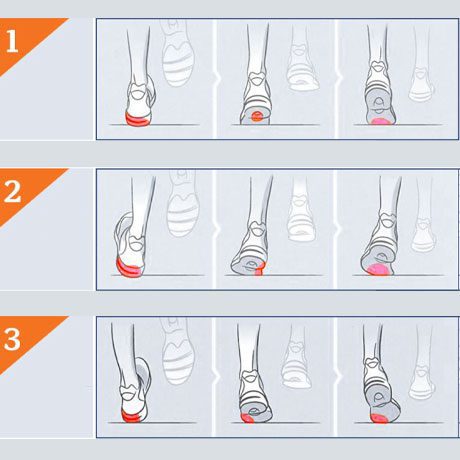

Stride types
Foot type: normal arch
Sole wear: S-shaped – it starts on the outer part of the heel and stops in line with the big toe
Frequency: 50% of the population
Foot type: flat foot (fallen arch)
Sole wear: on the inside of the soles
Frequency: 45% of the population
Foot type: cavus foot (high arch)
Sole wear: on the outside of the soles
Frequency: 5% of the population
It’s important for foot stability, protection and grip on uneven terrain. The stiffer the sole, the more responsive and dynamic it is, and the longer it’ll last. Opt for a stiff sole if you’re an experienced walker and intend on doing technical treks during your trip. But don’t forget the comfort aspect, because you’ll wear your shoes for many hours at a time and not only during treks.
Decent grip prevents you from slipping and injuring yourself. The grip of the shoe depends on the material used for the sole and its notching. Generally speaking, soft rubber has good grip on rocks, whether you’re ascending or descending, but they wear out faster. Harder rubber will last longer.
Good cushioning is synonymous with comfort and joint protection. Different brands use different technologies (air, gel, and so on) to absorb shocks with the ground. But, in general, the more cushioning, the heavier the shoe, as you need to add material.


Vibram – the world leader in high-performance soles
Comfort is another highly important aspect. Your feet expand when they’re warm, so make sure your feet are warm when you try on shoes (i.e. make sure you’ve walked about a bit before). Feel free to walk about in the shop as well. And, don’t just slip your foot into the shoe, always try it laced up.
You should feel supported, but not squashed. Your foot needs to feel as if it’s fully wrapped by the shoe, but without any pain or pressure points. Feel for them on the side of your foot as well as the instep and heel. Your foot should be almost locked at the heel: it can come up half a centimetre, but no more. If you have any doubts, don’t hesitate to try another pair out.
This is one of the most important elements when choosing shoes for a long trip. Don’t forget that you’ll probably spend a lot of your time in flip-flops in hot countries. So, you’ll have to carry your trail shoes or hiking boots in your backpack for many, many hours.
And there’ll be times when you’re really going to feel, and regret, every extra gram you packed…
If you intend on doing treks on rocky terrain, opt for a model with side and front protection (stone guard). They protect your toes from external elements (stones, rocks, etc.).
As you’ll wear your shoes almost every day in a wide variety of terrains and climates, they’ll undoubtedly undergo intense usage. Therefore, it’s better to invest in a brand recognised for the quality of its shoes.
It’s a pretty subjective criterion. For our part, Sylvain likes the look of trail shoes while François prefers to make do with basic city trainers to go more unnoticed.
Some shoe models are equipped with a quick lace system. So all you have to do is pull on a small handle to tighten the whole shoe. It then locks and hides in the tongue of the shoe.
Other models are kitted out with self-locking hooks. These are small hooks that allow you to lock the laces in place and that you cross over before tying the knot.
Good lateral foot support helps prevent you from twisting your ankles. High-cut models, which support the ankle joint and the lower shin, provide the best support. However, if there’s too much support, when you wear your shoes over a long period of time, the natural flexion of your ankle ligaments will decrease. The risk of injury will then be greater when you walk again with shoes without this support.
For this reason (and also because of their weightiness), we don’t recommend high-cut shoes for a RTW trip, unless your ankles are a bit weak but you still plan on doing lots of treks. Trust us, we know what we’re talking about, as Sylvain lugged around shoes like this for a year during our RTW trip.
Gore-Tex, often shortened to “GTX” is a specialised fabric membrane. It guarantees waterproofness while, in theory, maintaining breathability. The mesh is woven so that the pores are too small to let raindrops pass through it, but large enough for sweat to evaporate out of it.
Therefore, at first glance, you might think that it’s better to take Gore-Tex shoes on a RTW trip. However, it’s a controversial topic. Most sellers in specialised shops advise against them for trips to tropical countries.
Indeed, Gore-Tex provides good protection against moisture when walking in wet grass, in normal rain or in snow. But it won’t prevent your feet from getting very wet in extremely heavy rain (like monsoons) or if you have to walk in water with your shoes on. Quite the opposite, it’ll block the water inside. They’ll take much longer to dry than classic trail shoes that are equipped with breathable mesh. In hot weather, the sweat from your feet will also be trapped inside your shoes.
What’s more, Gore-Tex shoes are pricier and heavier than other models.
For all these reasons, we don’t recommend Gore-Tex shoes for a long trip in tropical countries.


How Gore-Tex technology works
You need to allow between $65 and $165 (£50 and £125) for a good pair of trail or hiking shoes. The cheapest being the Quechua ones sold at Decathlon. According to our survey results, however, lots of RTW travellers don’t think twice about investing in shoes from specialised brands, even if it means digging deep.
Here are the shoe brands that were the most used by our survey respondents during their RTW trip:
| Women | |
|---|---|
| Salomon | 20% |
| Merrell | 10% |
| Quechua | 10% |
| Nike | 9% |
| Adidas | 5% |
| Kalenji | 4% |
| Asics | 3% |
| Birkenstock | 3% |
| Converses | 3% |
| Scarpa | 2% |
| Men | |
|---|---|
| Salomon | 22% |
| Quechua | 13% |
| Merrell | 8% |
| Asics | 5% |
| Kalenji | 4% |
| Adidas | 4% |
| Nike | 4% |
| Columbia | 3% |
| The North Face | 3% |
| Timberland | 3% |
| High-cut walking shoes | Low-cut walking shoes | Trail shoes | Sports shoes | “City” or light canvas trainers | Sandals | Flip-flops | |
|---|---|---|---|---|---|---|---|
| Weight | |||||||
| Comfort | |||||||
| Durability | |||||||
| Support | |||||||
| Waterproofness | |||||||
| Drying time | |||||||
| Breathability | |||||||
| Protection | |||||||
| Grip | |||||||
| Cushioning | |||||||
| Knee shock absorption | |||||||
| Ankle flexibility support | |||||||
| Price |
In this section, we compare the most used trail shoe models and low-cut hiking boot models by RTW travellers according to our survey results.
| Model | Price comparison | Weight of one shoe (US size 12) | Shoe type | Pros | Cons | More info |
|---|---|---|---|---|---|---|
Adidas Terrex Swift R2
  |
$140 (£120)
Amazon Snowleader |
12.3 oz (350 g) |
Trail |
– Cushioning
– Durable |
– Weight | More info |
Asics Gel FujiTrabuco 6
  |
$130 (£110)
Amazon |
11.5 oz (325 g) |
Trail | – Comfortable | – Grip | More info |
La Sportiva Ultra Raptor
  |
$147 (£125)
Snowleader Amazon |
12.1 oz (343 g) |
Trail |
– Grip
– Stability |
– Responsiveness
– Price |
More info |
Merrell All Out Blaze Aero Sport
  |
$165 (£140)
Amazon |
11.3 oz (319 g) |
Low-cut hiking |
– Weight
– Ventilation |
– Dynamism | More info |
Merrell Moab 2 Ventilator
  |
105 € (£90)
Amazon |
12.9 oz (366 g) |
Low-cut hiking |
– Grip
– Stability |
– Responsiveness
– Price |
More info |
Quechua MH500
  |
$70 (£60)
Decathlon |
15.2 oz (430 g) |
Low-cut hiking |
– Price
– Waterproofness |
– Durability
– Weight |
More info |
Salomon Speedcross 5
  |
$147 (£125)
Snowleader Amazon |
11.3 oz (320 g) |
Trail |
– Quicklace
– Grip |
– Stiffness | More info |
Salomon X Ultra 3
  |
$140 (£120)
Amazon |
12.9 oz (365 g) |
Trail |
– Quicklace
– Stability |
– Weight | More info |
Salomon XA Pro 3D
  |
$147 (£125)
Snowleader Amazon |
13.4 oz (380 g) |
Trail |
– Quicklace
– Cushioning |
– Poids | More info |
| Model | Price comparison | Weight of one shoe (US size 12) | Shoe type | Pros | Cons | More info |
|---|---|---|---|---|---|---|
Adidas Terrex Swift R2 GTX
  |
$155 (£130)
Amazon |
10.9 oz (310 g) |
Trail |
– Cushioning
– Durability |
– Weight | More info |
Asics Gel FujiTrabuco 6
  |
$115 (£95)
Amazon |
11.5 oz (325 g) |
Trail | – Comfort | – Grip | More info |
La Sportiva Ultra Raptor W
  |
$165 (£140)
Snowleader Amazon |
10.3 oz (292 g) |
Trail |
– Grip
– Stability |
– Responsiveness
– Price |
More info |
Merrell All Out Blaze Aero Sport
  |
No longer sold See other models |
10 oz (283 g) |
Low-cut hiking |
– Weight
– Ventilation |
– Dynamism | More info |
Merrell Moab 2 Ventilator
  |
$89 (£75)
Amazon |
12.1 oz (343 g) |
Low-cut hiking |
– Grip
– Stability |
– Responsiveness
– Price |
More info |
Quechua MH500
  |
$70 (£60)
Decathlon |
12.6 oz (356 g) |
Low-cut hiking |
– Price
– Waterproofness |
– Durability
– Weight |
More info |
Salomon Speedcross 5 W
  |
$149 (£125)
Snowleader Amazon |
9.2 oz (260 g) |
Trail |
– Quicklace
– Grip |
– Stiffness | More info |
Salomon X Ultra 3 W
  |
$120 (£100)
Amazon |
11.3 oz (320 g) |
Trail |
– Quicklace
– Stability |
– Weight | More info |
Salomon XA Pro 3D W
  |
$172 (£145)
Snowleader Amazon |
12.5 oz (354 g) |
Trail |
– Quicklace
– Cushioning |
– Weight | More info |

